 Gilman Studio On-Line Lessons
Gilman Studio On-Line Lessons
Yang Style Long Form
Tai Chi Chuan
This Lesson Contains:
Standing Meditation (Zhan Zhuang)
Movement # 15 – Play the Fiddle
Standing Meditation
Standing meditation or Zhan Zhuang is an ancient form of Chi Kung that is gaining popularity in China and the rest of the world. This system is simple on the outside, and as deep as the universe on the inside. Standing exercises are extremely important to Tai Chi training, and the essence of self-healing.
The basic idea for all standing exercises is the use of the mind to move energy. These exercises can be as easy as just standing in a normal posture and breathing naturally, or as complex as twisting the body or sinking into a very deep posture and moving the breath in quite intricate patterns. In any case, the exercises always proceed from simple to complex as the student gains the necessary skills needed to use the mind to move energy.
- T. Liang, one of America’s leading Tai Chi masters, used the term “Imagination Becomes Reality” to describe how Tai Chi and standing meditation works. At first you imagine certain things, like holding a ball and feeling it expand and contract, or feeling energy circle in an orbit inside the body. Before long, you will actually be able to feel these sensations as the mind (Yi) acts on the energy (Chi) to create internal energy (Jing or Shen). These sensations are, at the beginning, quite obvious like tingling, shaking, vibrating, or heat. As the body opens and relaxation happens, the grosser sensations vanish and the movement of the finer energies becomes possible. In the final stages, time seems to vanish, the separate ego identity merges with the universal energy or Tao, and the person has realized his or her own potential. It is a journey requiring diligent and constant practice, yet is attainable by everyone. Many individuals throughout history have walked on this path, and their teaching can and should guide you. There are many pitfalls, obstacles, and quite difficult places, yet if you follow the advice of those who have gone before, and listen to your inner self, the potential problems will be minimized.
I will not try and discuss specific exercises here as there are many good books that include information on standing (the best I have found so far is The Way Of Energy by Master Lam Kam Chuen), but I want to give you a basic outline of how to proceed, and what the process will be.
1) Wear comfortable clothing and choose a quiet, well-ventilated place for practice.
2) Do a few warm up exercises to get the energy and body moving and relaxed.
3) Stand in the Wu Chi or beginning posture to get the body, breath, and mind in the same place at the same time.
4) Assume a posture, usually Holding a Ball.
5) Breathe naturally until the energy starts to increase and move.
6) Direct the movement of energy with the mind, starting simply and working up to more complex as the mind and body learn to control the Chi.
7) After practice, make sure to shake your body some and or rub your face and body.
The practice of Zhan Zhuang or standing meditation is enhanced by daily practice. If you do this, energy will continue to build. If you skip days, the energy will start to decline and you will have to build it back up each time you want to practice.
Movement # 15 – Play the Fiddle
This is the second application for Play the Fiddle. Here partner grabs the wrist from above. The first application (Movement #11), that of sealing downward with the right hand and then bringing up the left palm, will not work here. Instead, I circle my right arm, twisting Rex’s arm, and then apply Lieh Jin or “Splitting Energy” in a side-to-side fashion, not up and down as in the first application. This is a good example of the use of Chan Ssu Jin or “Silk Reeling Energy”.
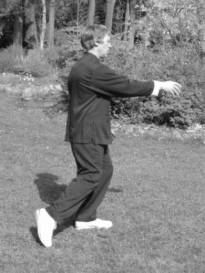
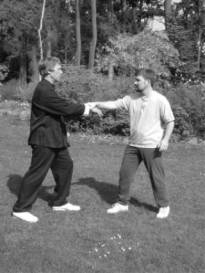 Partner grabs me from above with his right hand. I relax and sink more weight into my left Kua or hip area to gain root in case he pulls.
Partner grabs me from above with his right hand. I relax and sink more weight into my left Kua or hip area to gain root in case he pulls.
From the end of Left Brush Knee, relax the two hands, sink more into the forward foot and roll up the rear foot. I am ready to move forward, kick, or block with my right leg. Do not stand up on the left leg. Sink down.
Focus on the right wrist to stay connected and on the left hip and foot for a solid root.
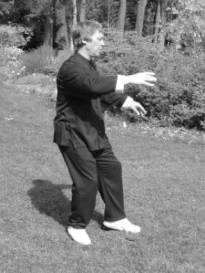
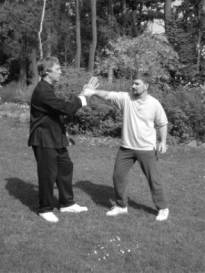 I reset my rear foot and shift the weight back onto it, pulling the left foot into Ding Bow on Toe. I could have reset the foot forward, next to, or as in this case, slightly to the rear. Resetting gives me the option of moving and sticking to my partner. Do not change the level of your body. At the same time, my right hand starts to circle in a clockwise fashion. Since Rex has chosen (quite unwisely) to hold on with his grip, his arm is twisted, putting pressure on his wrist, elbow, and shoulder. My left hand has started to rise up in a soft, clockwise circle.
I reset my rear foot and shift the weight back onto it, pulling the left foot into Ding Bow on Toe. I could have reset the foot forward, next to, or as in this case, slightly to the rear. Resetting gives me the option of moving and sticking to my partner. Do not change the level of your body. At the same time, my right hand starts to circle in a clockwise fashion. Since Rex has chosen (quite unwisely) to hold on with his grip, his arm is twisted, putting pressure on his wrist, elbow, and shoulder. My left hand has started to rise up in a soft, clockwise circle.
In Tai Chi we seldom hold on with a firm grip. That usually leads to all sorts of problems. We stick and follow which can’t be done with a strong grip.
Focus on the right wrist to stick and on the belly to generate the twisting energy.
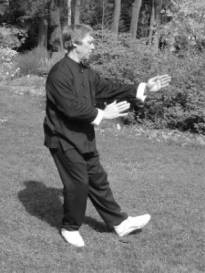
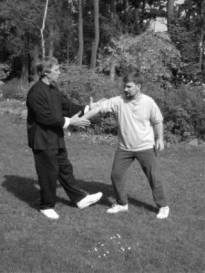 Rex has let go of my arm and my circling right arm ended up on his wrist while my left palm has come up to apply Lieh Jin or inward pressure to his elbow. The left foot does Ding Bow on Heel, which means I could have kicked Rex on the shin, knee or foot.
Rex has let go of my arm and my circling right arm ended up on his wrist while my left palm has come up to apply Lieh Jin or inward pressure to his elbow. The left foot does Ding Bow on Heel, which means I could have kicked Rex on the shin, knee or foot.
When changing from Ding Bow on Toe to Heel, just lift the leg a bit, then press down with the heel, but do not put any weight on the heel.
The body is now facing west. Don’t forget all directions relate to the direction you started, which was called north even if it wasn’t.
Focus on the inward pressure of the two palms and on the left heel for kicking.
This circling energy is called Chan Ssu and is used throughout the form. This is a good example of how it is applied.
